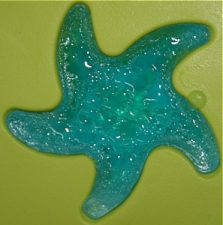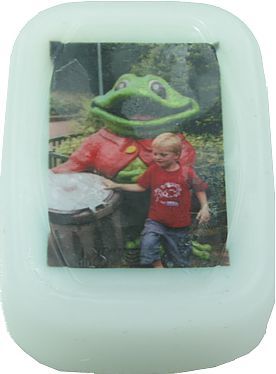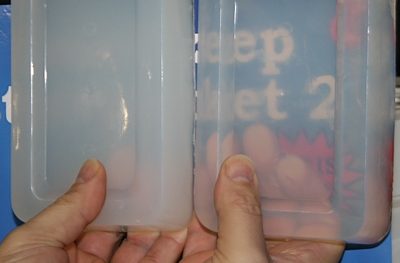Developed out of sheer frustration, sweat-free pour soap that stays dry.
Everything we made got wet and dripped. The fun was gone!
In 2007 we started making soaps and give workshops. We bought sweat-free pouring soap online for this purpose. It turned out that it did not stay dry but was dripping and the soaps were also getting smaller. The fun was over! For a long time we, like many others, thought there was no other way.

Out of sheer frustration, we delved very deeply into the process in 2010 to discover where the problem arose. And of course whether it could be solved. In 2012, we succeeded after 18 months of testing, and we were proud of the Alps, because we managed to do what someone else apparently couldn’t do.
Good news, we did it!
We have adapted meltable glycerine soap, better known as pour-on soap / melt soap, so that it does not get wet (does not sweat and does not condense), remains softer (practically does not break) and melts faster. Production is in the EU and the soap complies with cosmetics legislation.
How do we do it?
Of course, we won’t reveal the secret, it takes 18 months of development. We will give you a sneak peek: we change the amount of certain ingredients that cause the wetting problem. So we are not adding new dark ingredients as claimed by frustrated competition.
Imagine that ingredient 1 must be present in a smaller dose in the soap, then you add all the other ingredients. This means that ingredient 1 will be less in proportion!

Where is it going wrong?
That is the million dollar qwestion, heating it for too long and melting it in the wrong way is one of the causes. The composition of the soap changes, resulting in wet soaps. But certain dyes and fragrance oils can also cause wet soap. Even certain things that people put in the soap such as leaves can cause the problem.
Melting well is difficult, as is evident from the many stories on the net. Mistake number one is using the microwave, which doesn’t heat the entire soap at once. Just like your plate of food that comes out of the microwave, the outside jug is way too hot and the inside is cold. The outside has boiled and damaged the soap.
The only good way is to cut bells of soap and melt it in a bain marie. And if possible, with an induction hob that you can set to 60°C. And don’t forget to put the lid on the pan and melted is melted.
Melt processing tips
» Do not raise the temperature of the soap to more than 60°C
» Only melt in a bain marie, never use the microwave
» Do not heat longer than necessary, melted is melted
» Keep the lid on the pan and put everything that evaporates back into the soap
» Use limited color and fragrance (preferably only our products)
» If possible, use an induction hob at 60°C. No induction hob? then use a thermometer in the water
The problems we had to solve
» Make it more transparent, most soap is not really transparent
» Moisture / wet soap problem (condensation / sweating whatever it is called)
» Let it solidify less quickly so that you have longer to smell and colors
» Lower the melting temperature so that it is easier and safer to melt at home
» Soften, making it easier to puncture holes without the soap breaking
» Better / more even white, lots of soap on the net had white specks that were mostly at the bottom of the soap
Condensation, sweating, moisture. Annoyance number 1
It is definitely number 1 among the annoyances, moisture that comes into the soap creation. But where does the moisture come from? and can it be solved? Most pour-on soap/meltable glycerin soap is synthetically made. A required ingredient attracts moisture from the air and also ensures that the moisture is separated (soaps become smaller over time).
We call the secretion sweating, moisture comes out of the soap, which also makes it smaller. Then there is the attraction of moisture, which we call condensation. Moisture is extracted from the air and ends up on the soap.
Reduce melting temperature
The melting temperature of most glycerin soap is around 70°C. If this is melted in a bain marie, water of almost 80°C is required. This hot is of course undesirable with all the associated risks. We have managed to lower the melting temperature to just above 50°C.
More time to process
A lower melting temperature means that the soap remains liquid for longer (solidifies less quickly), giving more time to add the desired color and scent to the soap.
Make it more transparent
Beautiful transparent creations can be made with real transparent pouring soap, such as an object in the soap or a photo in the soap. but then you have to be able to see through it!
Most Glycerin pour soap for sale on the internet is advertised as transparent, but what is transparent? Judge yourself!

Softer soap
A problem we encounter at workshops is that soaps break while piercing the hole. Poking holes in the lengthwise direction is quite a task, if possible, try to stay straight! Because our new soap remains softer, it practically does not break and puncturing a hole has become a piece of cake.
Better/more even white
Many packages that we came across on the internet had the problem that the white is not evenly distributed throughout the soap. The brightener used is usually Titanium Dioxide, which is a pigment powder (pieces of stone) that cannot be dissolved but are distributed evenly. If the process is too fast, the Titanium Dioxide will sink, resulting in white speckles.
We have invested a lot of money in properly cooling the soap in an environmentally friendly way to avoid this problem. This also makes it possible to produce extra white soap.